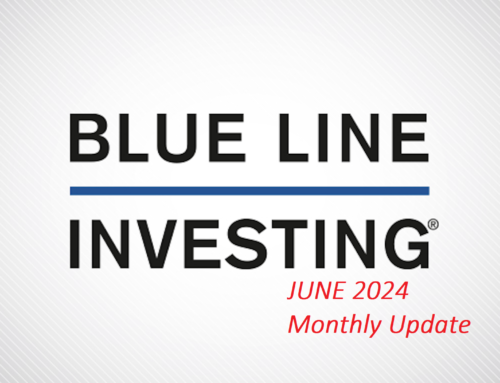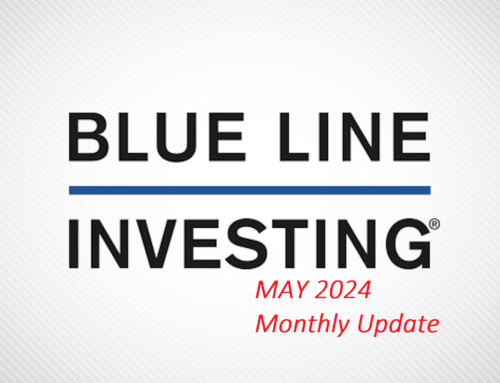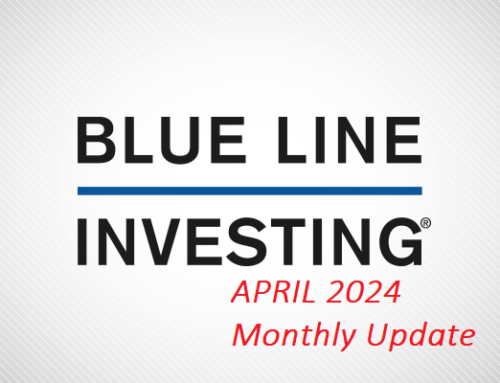“The only thing that is constant is change”
– Heraclitus
The US stock market, as measured by the S&P 500 Index (S&P), finished the month of December 8.40% above the BLUE LINE, compared to 7.10% at the end of November. As such, the current primary trend is categorized as a rising trend.
BLUE LINE PERSPECTIVE

Chart courtesy of StockCharts.com
As a quick reminder, we monitor the relationship between price and the BLUE LINE over time to help identify which stock markets worldwide are experiencing rising primary trends, sideways primary trends, and declining primary trends. We prefer to invest in those markets experiencing rising or sideways primary trends, while avoiding those markets experiencing declining primary trends. The BLUE LINE helps us identify these trends – and when changes may be taking place between them.
At the present time, my primary concern pertains to the “steepness” of the current price rise. Just two years ago the S&P experienced a steep rise where price exceeded the BLUE LINE by almost 13%, right before it experienced a violent price correction back to the BLUE LINE. Please refer to the red circle on the chart below, courtesy of StockCharts.com.

Chart courtesy of StockCharts.com
Whether the US stock market is currently rising because of “a good economy”, capital flight out of the Eurozone, or some other reason entirely, sharp price rises tend to be followed by sharp price declines. While the past does not have to repeat, I believe this bears close monitoring over the coming weeks.
TOP HEAVY(er?)
In a special report published to this blog on November 15, 2019, a reference was made to the top five largest stocks in the S&P 500 Index measured by market capitalization. If you would like to read it, please click here. Out of the 505 stocks that comprise the S&P, Apple, Inc. was the second largest at that time with a weight of 4.34%. In other words, price changes to Apple stock alone will likely impact the price of the index to a larger degree than the combined smallest 100+ stocks of the index.

Chart courtesy of StockCharts.com
As of the end of December, Apple now represents the largest weight in the S&P. Of the 30 stocks that comprise the Dow Jones Industrial Average, Apple is now the third largest priced stock and represents 6.97% of that index. And of the 100 stocks that comprise the Nasdaq 100, Apple is also the largest weight, representing 11.6% of the index. This information is as of December 31, 2019 and can be found at www.slickcharts.com.
It is interesting to note that Apple’s stock price is trading 31% above its BLUE LINE, which according to the BLUE LINE INVESTING® process is high. This is being pointed out to illustrate that the major US stock indices are becoming more top heavy with each passing day.
Thank you for reading the BLUE LINE INVESTING® PRIMARY TREND update, and please do not hesitate to call (833) 258-2583 with questions or if we may be of service.
Jeff Link
Would you find this service more beneficial in video format? If so, please let me know by sending an email to [email protected]. I am considering changing format to a Zoom presentation to narrate this in the future for further clarity.
Disclaimers:
BLUE LINE INVESTING® (BLI) is an investment process that seeks to align investment decisions with the prevailing primary trend of the financial markets. BLI seeks to remain fully invested when the financial markets are experiencing either a long-term rising primary trend or a short-to-intermediate sideways trend. When the primary trend begins declining however, the process follows a 3-phase sell process to attempt to limit downside loss. We believe Warren Buffett said it best with his two rules: “Rule No. 1 – Never lose money. Rule No. 2 – Never forget Rule No. 1.”
The S&P 500 Index is one of the most commonly followed equity indices, and many consider it one of the best representations of the U.S. stock market, and a bellwether for the U.S. economy. It is comprised of 500 large companies having common stock listed on the NYSE or NASDAQ. The volatility (beta) of the account may be greater or less than the index. It is not possible to invest directly in this index.
Technical analysis is a method of evaluating securities by analyzing statistics generated by market activity, such as past prices and volumes. Technical analysis attempts to predict a future stock price or direction based on market trends. The assumption is that the market follows discernible patterns and if these patterns can be identified then a prediction can be made. The risk is that markets may not always follow patterns. There are certain limitations to technical analysis research, such as the calculation results being impacted by changes in security price during periods of market volatility. Technical analysis is one of many indicators that may be used to analyze market data for investing purposes and should not be considered a guaranteed prediction of market activity. The opinions expressed are those of BLI. The opinions referenced are as of the date of publication and are subject to change without notice. BLI reserves the right to modify its current investment strategies based on changing market dynamics or client needs.
Past performance is not indicative of future results. This material is not financial advice or an offer to sell any product. The information contained herein should not be considered a recommendation to purchase or sell any particular security. Forward looking statements cannot be guaranteed.
Advisory services offered through Aptus Capital Advisors, LLC, a Registered Investment Adviser registered with the Securities and Exchange Commission. Registration does not imply a certain level or skill or training. More information about the advisor, its investment strategies and objectives, is included in the firm’s Form ADV Part 2, which can be obtained, at no charge, by calling (251) 517-7198. Aptus Capital Advisors, LLC is headquartered in Fairhope, Alabama.
ACA-19-42




